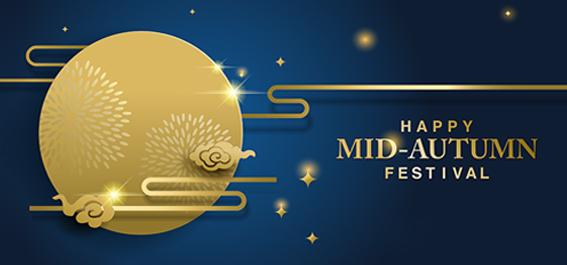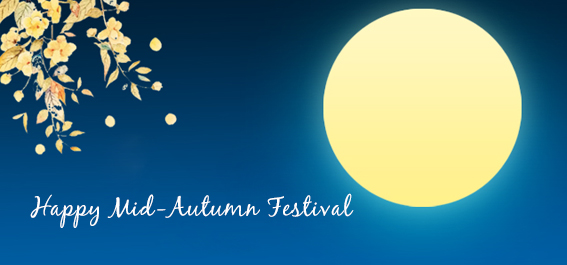Mid-Autumn Day

The Mid-Autumn Festival (alias: Mid-Autumn Festival, Autumn Eve, August Festival, Half Moon Festival, English name: Midautumn Festival) is one of the four traditional Chinese festivals, dated on August 15th of the lunar calendar.
Since ancient times, the Mid-Autumn Festival has had folk customs such as worshipping the moon, admiring the moon, eating moon cakes, playing lanterns, admiring osmanthus flowers, and drinking osmanthus wine. Later, people gradually combined moon viewing with moon cakes, which meant family reunion and yearning. At the same time, moon cakes are also a gift for friendships between friends during the Mid-Autumn Festival.

Foreign customs
Korean Peninsula
In Korean, it is called "추석 (秋夕)", "중추절 (仲秋节)", "가배 (嘉俳)", "중추 (仲秋)", "가배일 (嘉俳日)", "중추가절 (仲秋节)". It is a day to visit the graves and sacrifice to ancestors with the newly harvested grains and fruits. It is also the custom of the Mid-Autumn Festival to return home to visit relatives and give gifts to relatives and friends. Therefore, English also refers to the Mid-Autumn Festival on the Korean Peninsula as "Korean Thanksgiving Day" (Korean Thanksgiving Day).
Vietnam
The Mid-Autumn Festival is also a festival for Vietnamese children. That night, the children listened to the legend about Agui and went to see the lion dance. Some even got the father to buy him a lion for lion dance to play with their friends. Vietnamese children have to go out and play with carp lanterns on the night of the Mid-Autumn Festival, which also indicates the meaning of "jumping the dragon gate" when they grow up.
Japan
The traditional Japanese Mid-Autumn Festival is called Fifteen Nights, also called Mid-Autumn Moon and Taro Moon. The Japanese eat glutinous rice dumplings when admiring the moon, called "Moonmi dumplings". Since this period coincides with the harvest season of various crops, in order to express gratitude for the blessings of nature, the Japanese hold various celebrations. Japanese people also enjoy the moon, which is called "Moonmi", and the house will display moon-viewing dumplings, miscanthus, taro, etc.
Ryukyu
In addition to worshipping the ancestors and the moon during the Mid-Autumn Festival, the Ryukyu people also worship the stove. Thank you, Mr. Zao, for blessing your home within a year. In addition to eating moon cakes, they will eat a food called puffing cakes, which are rice cakes with red beans on the surface. In addition, there are customs of tug-of-war, lion dance, and dance.
The Mid-Autumn Festival is also a day for family reunion. People will return to their homes to eat together, reunite, and worship their ancestors to thank their ancestors for their blessing. They also eat certain foods, many of which are related to the moon and reunion. These foods are also sacrifices to the moon. For example, the Chinese (Han), Vietnamese (King), and Ryukyu people have the custom of eating moon cakes; Guangdong and Hong Kong Some people use mooncakes instead of mooncakes; Japanese people (Yamato) eat tsukimi dumplings, and some areas will fry sun eggs. Mooncakes, moonlight cakes, yuki danzi, and sun eggs are all round, representing the full moon; Koreans What is eaten is a half-moon-shaped pine chip, which symbolizes the moon's turn from deficit to profit. In addition to moon cakes, Ryukyu people also eat puffy cakes. In addition, seasonal fruits and other crops such as carambola, grapefruit, taro, chestnut, water chestnut, pear, persimmon, etc., are farmers’ autumn harvests in farming society, as well as food and sacrifices for the Mid-Autumn Festival.
Singapore
Singapore is a country with the majority of the Chinese population, and has always attached great importance to the annual Mid-Autumn Festival. For Chinese in Singapore, the Mid-Autumn Festival is a god-given opportunity to connect and express gratitude. Relatives, friends, and business partners give moon cakes to each other to express greetings and wishes.
Malaysia, Philippines
Eating moon cakes, admiring the moon, and carrying lanterns to parade are the Mid-Autumn Festival custom passed down from generation to generation by Malaysian Chinese. As
Cambodia
Cambodians "Moon Worship Festival": Cambodians hold a traditional "Moon Worship Festival" in December of the Buddhist calendar. In the early morning of that day, people began to prepare gifts for the moon. When they went to the treetops that month, they worshipped the moon and prayed for blessings. Bye, the old man stuffed the flat rice into the child's mouth until it was too full to chew. This means "consummation", "harmony and beauty".
Mid-Autumn Festival
In ancient times, the Han nationality’s Mid-Autumn Festival banquet was most refined in the palace. For example, the Ming court was fashionable to eat crabs. After the crabs were steamed with calf buns, they were gathered around to taste, served with wine vinegar. After eating and drinking Suye Decoction, wash your hands with it. The banquet area week is filled with flowers, big pomegranates and other seasonal products, performing Mid-Autumn Festival mythical operas. The Palace of the Qing Dynasty usually placed a screen to the east in a certain courtyard. On both sides of the screen were placed cockscomb, edamame, taro, peanut, radish, and fresh lotus root. There is a table of Eight Immortals in front of the screen, on which is set an extra-large moon cake, surrounded by pastries and fruits. After the sacrifice of the moon, the moon cakes were cut into several pieces according to the royal population, and each person took a symbolic bite. The name was "eat reunion cake". The size of the moon cakes of the Qing Palace is unimaginable. For example, the last emperor Pu Yi gave a moon cake to the Minister of Internal Affairs, Shao Ying, which was "approximately two feet in diameter and weighing about twenty catties."
